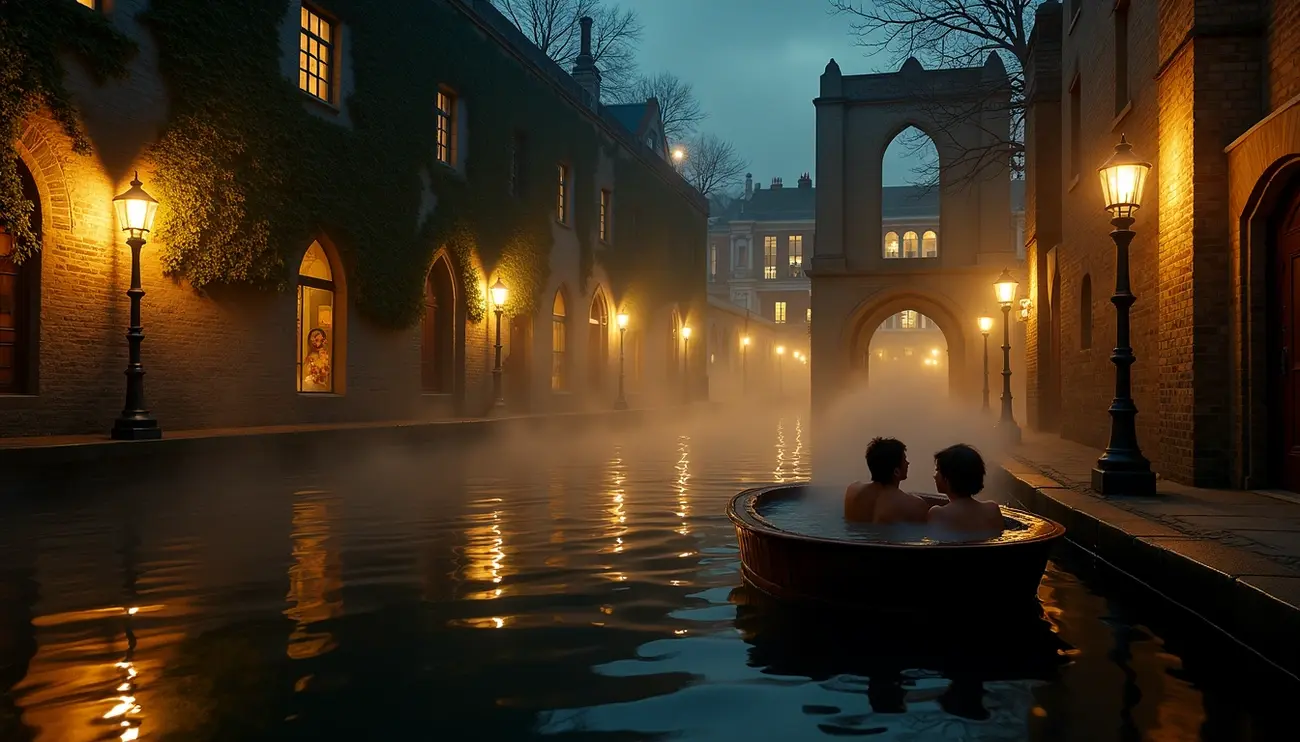Honestly, are you tired of the same old London Eye and Buckingham Palace? The quirky things to do in London actually go far beyond what the usual guidebooks show you.
While millions of people flock to the typical tourist spots, I’ve discovered a secret side of the city that’s much more fascinating. Just imagine sleeping next to lions at London Zoo, riding a once-secret mail tube deep beneath the city streets, or even bathing in red wine at AIRE Ancient Baths in Covent Garden! London also holds some truly bizarre treasures, like the Viktor Wynd Museum of Curiosities with its eccentric taxidermy collection. Then there’s the Fan Museum in Greenwich, which shows off over 5,000 handheld fans – that’s the largest collection in the whole world.
These unusual things to do in London offer a brilliant change from standard sightseeing. From enjoying artisan cheese from a conveyor belt at The Cheese Bar to attending jazz-age parties at the secretive Candlelight Club, the city’s weird attractions are sure to give you some unforgettable experiences. As someone who’s explored both the well-trodden paths and the more alternative things to do in London, I’m really excited to share 17 fun, quirky things to do in London that most visitors miss but absolutely shouldn’t.
Stay Overnight at London Zoo Lodges: A Roaring Good Time!
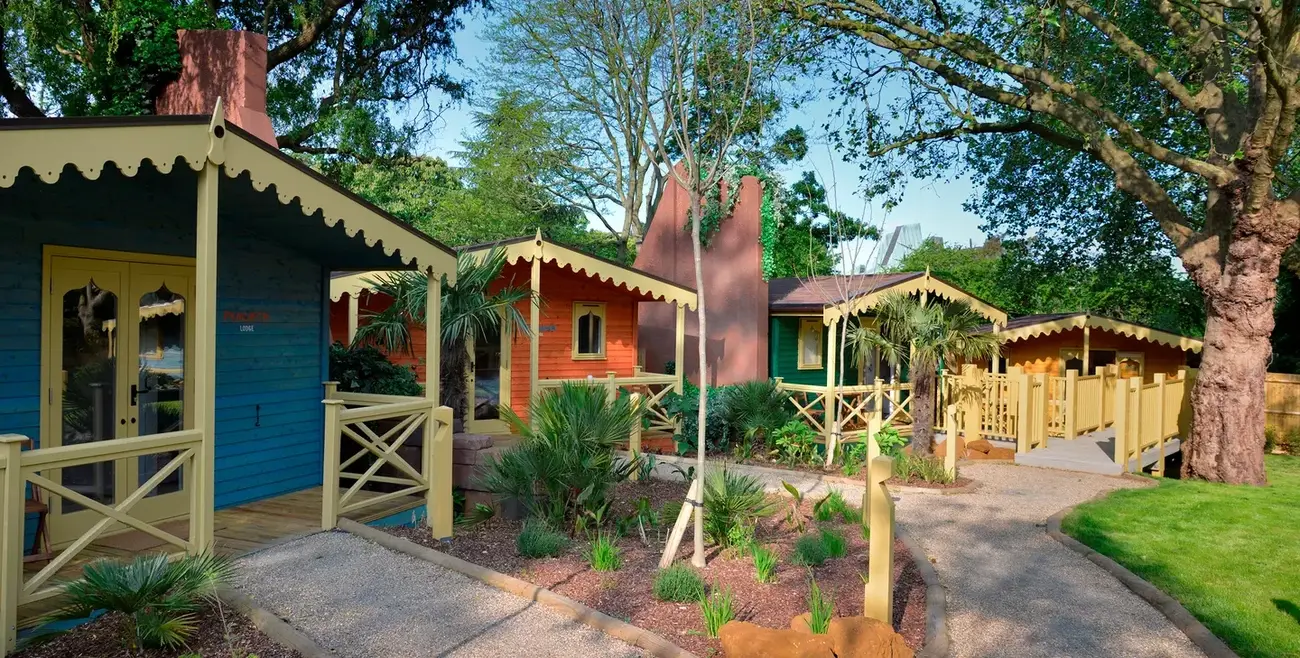
Image Source: London Zoo
Ever dreamed of waking up to the sound of actual roaring lions? Well, at London Zoo Lodges, that dream can become your reality! Tucked away right in the heart of London’s oldest scientific zoo, these nine colourful wooden cabins, inspired by Gujarati designs, offer one of the most unusual and quirky things to do in London if you fancy a unique place to stay.
Zoo Lodges Experience: More Than Just a Bed for the Night
Your overnight adventure kicks off with a chance to explore the zoo during the day – you can pop in anytime from 10 am on your arrival day. After you check into your private lodge around 4:30 pm, you’ll get to go on exclusive after-hours tours when the zoo is completely closed to the public. How cool is that? The experience includes three guided tours – one at sunset, one after dark, and another in the morning. You’ll get to see what the animals get up to at night and watch them as they wake up.
Each cosy lodge has its own en-suite bathroom with a shower, comfy beds with soft linen, tea and coffee making bits, and even free Wi-Fi. Plus, your stay includes a welcome drink when you arrive, a tasty two-course dinner, and a buffet breakfast in the morning. And here’s a real perk – you even get free entry to both London Zoo and Whipsnade Zoo for two whole days! This fantastic experience could be one of those brilliant fun things to do in London with kids that the whole family will remember.
Why It’s One of the Most Quirky Things to Do in London: Lions Next Door!
The most thrilling part? Your lodge is just a whisker away from the Asiatic lion pride! Imagine drifting off to sleep and maybe even waking up at 5 am to the powerful roar of lions – previous guests have called it “pretty damn special.” And it gets better! You’ll also enjoy some amazing behind-the-scenes privileges, like feeding warthogs, pygmy hippos, and aardvarks. You can even use night vision goggles to watch the nocturnal creatures. It’s a world away from your average hotel stay, that’s for sure!
How to Book Your Wild Night: Tips and Prices
This amazing experience runs from February to December. They offer adult-only nights (for guests aged 14 and over) and family nights (for children aged 5-13). Prices start from about £438 for two adults and two children on the family nights. If you’re a Gold Member of the zoo, you can get a discount, and they have accessible lodges too.
For the best chance of grabbing this really sought-after experience, I’d definitely book several months in advance, especially if you’re looking at peak season. With only nine lodges available, you can’t really just turn up and hope for the best! It’s one of those quirky things to do in London that needs a bit of planning.
Explore the Neon Wonderland of God’s Own Junkyard: A Visual Feast!
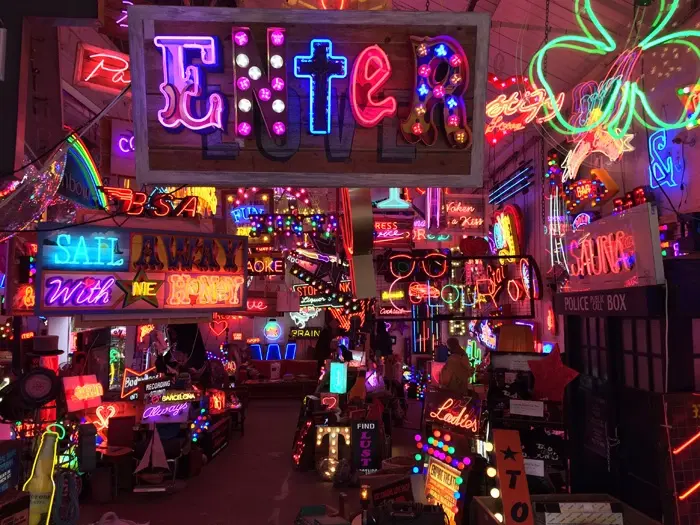
Image Source: www.godsownjunkyard.co.uk
Looking for a proper psychedelic feast for your eyes? Well, hidden away in an unassuming corner of Walthamstow, God’s Own Junkyard is a dazzling temple of neon light that’s quite unlike anything else in London. This fluorescent wonderland houses the largest collection of vintage neon signs in Europe! It’s managed to transform what was once a junkyard into an electrifying art experience. Honestly, it feels like stepping right into some kind of hallucinatory dream. This is definitely one of the top quirky things to do in London if you’re after something visually stunning.
God’s Own Junkyard Highlights: Signs, Props, and Pure Magic
This glowing collection is the life’s work of the late artist Chris Bracey, who was famously nicknamed “The Neon Man.” He actually created signs for many Soho establishments and even for Hollywood films like “Blade Runner” and “Eyes Wide Shut.” The warehouse is absolutely bursting with hundreds of salvaged neon signs, glittery disco balls, old movie props, and all sorts of retro displays. They’re all arranged in a gloriously chaotic, yet totally wonderful, fashion.
Every time I visit, I spot something new! You might see a provocative Soho club sign nestled right beside some religious iconography, or find movie memorabilia glowing in crazy psychedelic colours. It’s so different from traditional, stuffy galleries with their hushed atmospheres. This vibrant space really encourages you to take photos and just casually explore. The sensory overload of all the colours, shapes, and retro designs makes it one of the most unique and quirky things to do in London for art lovers and photographers alike. It’s almost as mind-blowing as some of those amazing immersive experiences in London I’ve tried!
Best Time to Visit: Catch the Glow
God’s Own Junkyard is only open from Friday to Sunday, and the hours are a bit limited (11 am to 9 pm on Fridays and Saturdays, and 11 am to 6 pm on Sundays). I’d say arriving early definitely helps you avoid the biggest crowds, especially on Saturdays when it can get busiest around midday. The space also transforms as the daylight changes. If you go in the morning, you get clearer views of the individual pieces. But, visiting in the afternoon or evening creates a much more immersive neon experience as the warehouse gets darker and the signs really pop.
Cafe and Photo Ops: Cakes and Instagram Dreams
They’ve got a great little cafe on-site called The Rolling Scones. It serves reasonably priced tea, coffee, and lovely homemade cakes. You can also grab alcoholic drinks like beer, wine, and prosecco. This makes God’s Own Junkyard perfect if you fancy an unusual afternoon tea experience, surrounded by all that glowing artwork. Maybe it’s a fun alternative to the more traditional best London afternoon tea spots?
For anyone who loves taking photos, the entire space offers endless chances for cool shots. Try capturing reflections in the disco balls or playing around with long exposures if you’ve got a decent camera. And remember to tag your social media posts with #GodsOwnJunkyard to join the community of people admiring this truly quirky London gem!
Take a Ride in a Floating Hot Tub on the Thames: Bubble Your Troubles Away!

Image Source: Shy, Strange, Manic
Now this is one of those quirky things to do in London that’s properly unique! For a truly immersive way to see the Thames, I don’t think anything beats lounging in a wood-fired hot tub while you float through London’s historic docklands. Honestly, this quirky water adventure offers a completely fresh view of the city’s waterways.
Hot Tub Boat Experience: What’s the Deal?
These custom-designed electric boats come with their very own freshwater hot tubs, heated up to a super toasty 38°C (that’s 100°F)! And don’t worry about hygiene – they change the water after every single trip. Your bubbly adventure lasts for about 75 minutes. During that time, you’ll slowly cruise through the impressive Canary Wharf docklands, all while soaking in lovely warm, bubbling water. It means the experience is delightful, no matter what London’s famously unpredictable weather decides to throw at you!
The boats are actually self-drive and really easy to operate, so you don’t need any boating experience at all. Each boat can hold up to seven people, making it a nice, intimate yet social experience. You can even choose between hiring a boat just for your group (private charters) or going on a guided tour with an experienced guide who’ll share some fascinating stories about the area’s history.
Where It Happens: Docklands Drifting
Skuna Boats, the company that runs these, operates from West India Quay in Canary Wharf. You’ll find them just off Hertsmere Road, right opposite the Museum of London Docklands. The location itself gives you excellent views of the 18th-century docklands and Canary Wharf’s impressive skyline. When you get there, look out for their black-painted hut – that’s where the friendly staff will welcome you. It’s quite a change of scenery from the usual best shopping in London!
Booking Tips: Plan Your Soak!
Prices for the shared guided tours start at £39 per person, but you can also book the whole boat privately. These unique tours generally run from Thursday through to Sunday, with the first sailing at 10 am and the last one at 8:30 pm.
Now, I’d really recommend booking this one in advance. It’s a very popular attraction, and I’ve heard it often gets booked up to 41 days ahead! So, a bit of planning is needed for this quirky London treat.
Before you go, remember to bring your swimwear and a towel (though you can rent towels if you forget). They even provide waterproof cases for your phones so you can snap some pics, and there are lockers to keep your belongings safe. You can also buy drinks at their on-site bar before you set off (they limit it to two per person). Given how unique and intimate it is, I think this makes for a really ideal unusual date activity or just a super memorable outing with your mates. It’s certainly one of the most fun and quirky things to do in London!
Visit the Viktor Wynd Museum of Curiosities: London’s Strangest Spot?
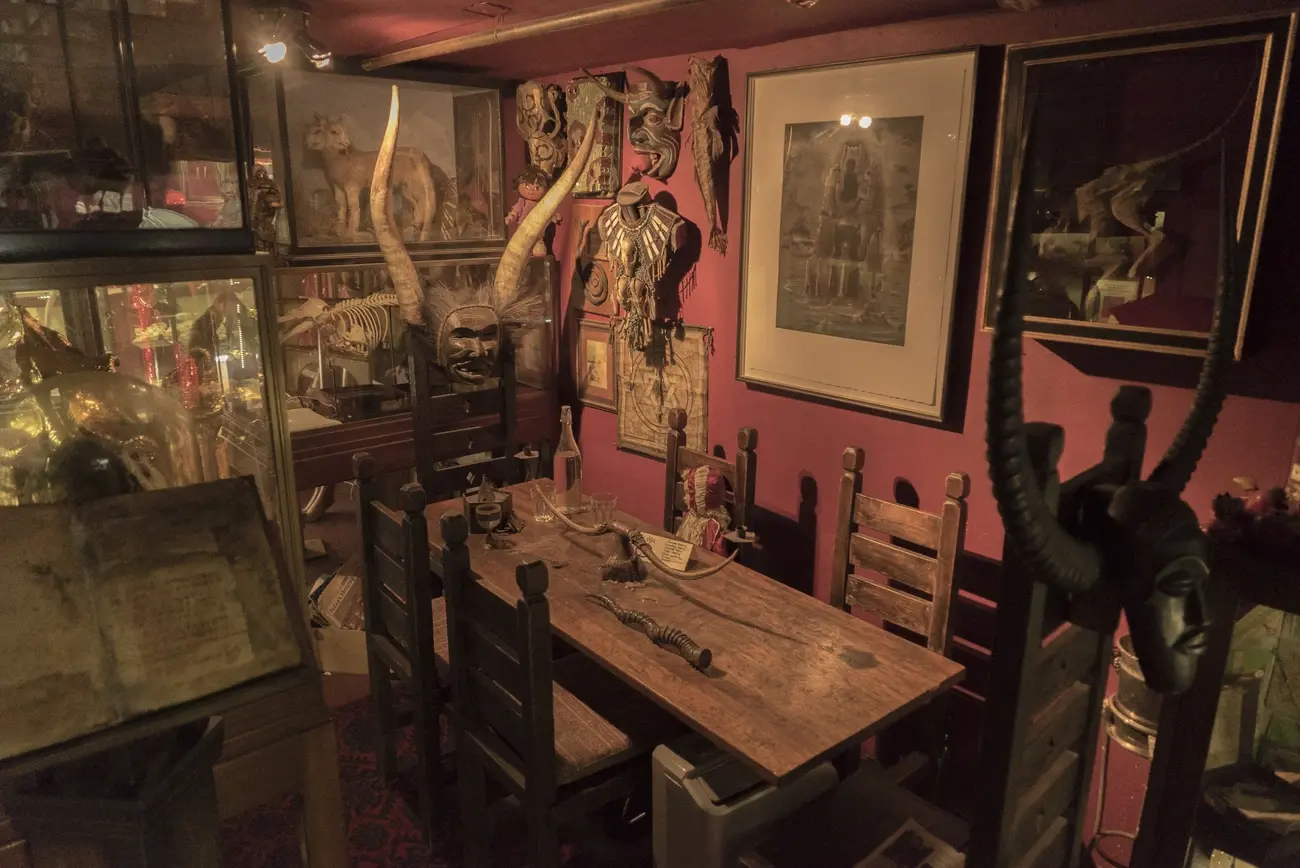
Image Source: Wikipedia
Hidden away in East London’s Mare Street, you’ll find what might just be London’s strangest museum. It’s a proper cabinet of curiosities that, honestly, seems to challenge good taste and categorisation all at once! The Viktor Wynd Museum offers what I think is possibly the most unusual hour you’ll spend in the capital. It’s become an absolutely essential stop for anyone hunting for truly quirky things to do in London.
What’s Inside: From Dodo Bones to Celebrity Poo!
When you head down the narrow spiral staircase, you’ll discover a slightly claustrophobic basement that is absolutely overflowing with oddities. They’re arranged without any real logical order, which is all part of its charm! The collection includes genuine dodo bones, actual shrunken heads, taxidermied animals with two heads, and feathers from extinct birds.
But these natural wonders share space with some distinctly unnatural things – from occult paintings to Victorian sex toys! The museum also boasts the largest public collection of works by the artist Austin Osman Spare. And, it’s said to have the country’s biggest collection of pieces by the surrealist Leonora Carrington.
Among the exhibits that get people talking the most are some very unusual bits of celebrity memorabilia. We’re talking about Russell Brand’s pubic hair, used Rolling Stones condoms, and yes, even samples of celebrity poo preserved in jars! It’s certainly not your average museum trip, and a world away from looking at exhibits in the free museums in London (though I love those too!).
Why It’s So Weird: No Explanations, Just Wonder!
Unlike traditional museums that try to educate and classify everything, this ‘Wunderkabinett’, as they call it, “seeks not to educate but to subvert, to show the world not in a grain of sand, but in a Hackney basement.” I love that! The museum’s philosophy places priceless scientific specimens right alongside McDonald’s Happy Meal toys, treating them with equal importance.
The atmosphere feels like you’re “stepping into a Victorian explorer’s twisted wonderland,” with the air thick with incense and lots of velvet. Perhaps the most notable thing is that the museum makes absolutely no attempt to explain its collection. You won’t find any information cards or educational displays, just pure, and sometimes unsettling, spectacle. It’s one of those quirky things to do in London that will leave you with plenty to talk about.
Location and Entry: Your Ticket to the Bizarre
You’ll find this bizarre treasure trove at 11 Mare Street, London E8 4RP. Admission to the museum (the Wunderkabinett) costs £10 for adults and £6 for concessions. However, the price drops to £8 if you have a bar reservation at their equally eccentric Absinthe Parlor upstairs, The Last Tuesday Society.
The museum opens Tuesday through to Friday from 3 pm to 11 pm, and on weekends from 12 pm to 11 pm. Just a heads-up, children under 18 are only allowed in before 5 pm and must be with an adult. And honestly, given the adult nature of many exhibits, that’s pretty understandable!
Attend a Pitch Black Playback Listening Party: Hear Music Like Never Before!

Image Source: Pitchblack Playback
Ever properly listened to your favourite album in complete darkness? I mean, pitch black? At Pitch Black Playback, your sense of hearing totally takes centre stage as all the lights go out. This creates one of the most unusual and quirky things to do in London for music lovers, and honestly, it’s a game changer!
What Is Pitch Black Playback: The Ultimate Deep Listen
This unique listening experience plays full albums through powerful cinema sound systems, but in absolutely pitch-black rooms. It was founded by a DJ and producer called Ben Gomori, and his whole idea is to try and revive the disappearing art of really appreciating an album as a whole piece of work.
These sessions are usually held in independent cinemas with comfy seating. And they don’t mess about with the sound quality – they play high-quality uncompressed audio files, never those squashed MP3-type formats. The organisers even “upmix” stereo recordings to surround sound. This means the music feels like it’s coming from all around you, rather than just from the front. It’s a completely different way to listen to music. Some people have described it as being like “time travel” or even an “out-of-body experience.” It’s pretty intense!
Why It’s Unique: A New Way to Connect with Music
Pitch Black Playback has even got the thumbs up from music legends like Rick Rubin. He said, “When I listen to music, I close my eyes, and it takes me away.” The electronic duo Autechre also pointed out that, “Something happens when you listen to music either with your eyes closed or in the dark. The music reaches further into you.” And I totally agree!
With absolutely no visual distractions, your hearing sharpens up to what they call “bat-like levels of perception.” It means you can experience music like never before. So, the experience becomes this really cool communal thing because you’re sharing the space silently with other people, but it’s also deeply personal as you connect with the music on your own terms. The producer Max Richter even calls it “the optimal way to listen to an album.” High praise indeed! For a truly different night out, this beats just another trip to one of the funniest comedy clubs in London, though those are great too!
How to Join: Get Your Ears Ready!
These events happen regularly around London and feature both classic albums and sometimes even exclusive pre-release premieres. When you arrive, you can usually grab a drink if the venue has a bar, then you take your seat, and they even give you a Pitchblack Playback eye mask for complete immersion.
Then, it’s phones off, silenced, and tucked away in pockets – no talking, whispering, or singing along is allowed. The lights go out, and they play the album, loud and in full, in the dark. That’s it! Often, food is available at the venues before or after the playback if you fancy a bite.
Tickets usually cost about £11 per person. Just a little note: even though it’s super dark, fire safety rules mean the exit lights have to stay on – which is why they give you the eye masks. To find out about upcoming sessions and to book your tickets, you just need to visit their website, pitchblackplayback.com, where they list all the events by city. This is definitely one of the most quirky things to do in London if you’re serious about your music.
Tour the Abandoned Aldwych Tube Station: A Ghostly Ride into History!
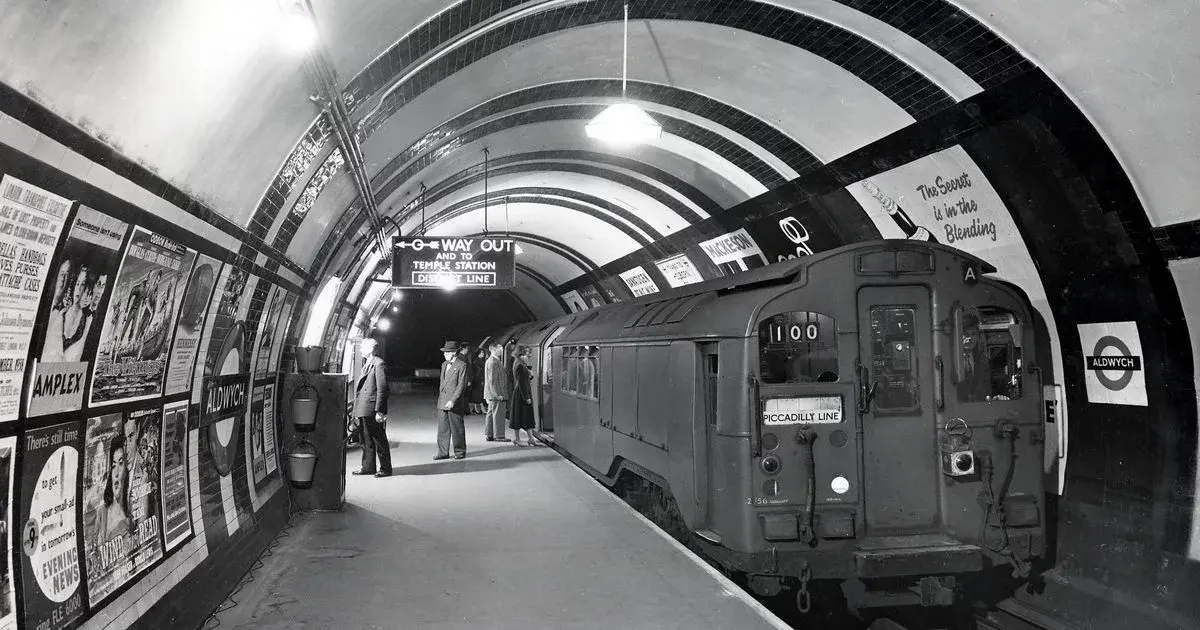
Image Source: London Transport Museum
Want to step beneath London’s busy streets and into a perfectly preserved time capsule? Then you absolutely have to check out Aldwych station! It’s a disused Tube stop that offers one of the most unusual and quirky things to do in London if you want to experience the city’s hidden history first-hand.
History of Aldwych Station: More Than Just a Tube Stop
This station has a truly fascinating past. It originally opened way back in 1907 and was called “Strand Station.” It was the end of the line for the Piccadilly line. It was designed by the architect Leslie Green – you might recognise his work from other old Tube stations with those classic ox-blood red tiles on the outside. Aldwych was actually built on the site where the Royal Strand Theatre once stood.
Now, even though they expected it to be super busy, passenger numbers were always surprisingly low. At its peak, only about 450 people were using it regularly each day! Because of this, one platform closed down as early as 1917. The other platform kept going until the whole station finally shut for good in 1994. The main reason? It was going to cost a whopping £3 million to replace the original wooden lifts, and they just couldn’t justify it.
But here’s where it gets really interesting! Throughout its life, Aldwych station was used for some extraordinary things beyond just transporting people. During both World Wars, it became a shelter for Londoners during air raids. And get this – it also housed priceless treasures from the British Museum, including the famous Elgin Marbles, keeping them safe from wartime destruction! I’ve heard that people shared first-hand accounts of bringing picnic baskets down to the platforms during the Blitz. They even had basic medical care and sometimes entertainment down there. What an incredible piece of London history, and a world away from the typical free museums in London you might visit!
Tour Details: How to See This Hidden Gem
The brilliant London Transport Museum runs special tours called “Aldwych: The End of the Line.” For 2025, these are scheduled to run from May through to August.
Each tour lasts about 75 minutes. Tickets cost £45 for adults and £42 for concessions and children. The tours run at various times – usually at 5:05 pm and 7:00 pm on weekdays, and then at 10:05 am, 12:00 pm, 2:40 pm, and 4:35 pm on weekends. You’ll meet your guide outside the main entrance of the station on Surrey Street.
What to Expect: Stepping Back in Time
When you arrive, the expert guides will lead you through the beautifully preserved Leslie Green architecture. It really does feel like stepping back in time. You’ll get to explore the ticket hall with its original 1907 features, step into the only remaining wooden trapezoid lifts on the entire Tube network (how amazing is that?!), and walk along the abandoned platforms. They’re still adorned with advertising posters that are decades old!
Perhaps one of the most thrilling bits for film and TV fans is seeing all the locations that have been used in countless productions. We’re talking big films like Darkest Hour, Atonement, and V for Vendetta. Plus, loads of TV shows like Sherlock, Luther, and Mr. Selfridge have filmed scenes down here.
Just a quick heads-up for visitors: the tour involves quite a few steps – 160 of them, in fact – to get between the ground level and the platform level. And, there’s no step-free access or working lift. So, sturdy footwear is absolutely essential for this fascinating journey into one of London’s best-kept secrets. It’s truly one of the most quirky things to do in London!
Sing Karaoke with a Live Organ at Organoke: Heavenly Hits!

Image Source: OutSavvy.com
Among all the quirky things to do in London, this one has to be up there for sheer bizarre brilliance! Organoke is a truly unique twist on traditional karaoke. Forget those dodgy pre-recorded backing tracks – here, your singing is accompanied by the absolutely thunderous sounds of a massive church organ! How amazing is that?
Organoke Experience: Sing Your Heart Out (Literally!)
Organoke has this really cool two-part format that keeps everyone, even the shyest singers, totally engaged. The first half is all about mass communal singing. Everyone joins together for some of the best pop classics you can imagine, all played on the mighty organ. It’s such a laugh!
Then, for the second half, brave souls get a chance to take centre stage – but only if the “Tombola of Dreams” picks your name out! The whole brilliant experience is guided by the fabulous host Ida Barr. She describes herself as a “rapping pensioner in faded Edwardian grandeur,” and honestly, she’s amazing at getting the crowd going.
Meanwhile, the super-talented, classically trained organist Ashley Valentine is the one taming the mighty instrument. He transforms pop hits into these magnificent organ arrangements that you just have to hear to believe. As the event organisers themselves say, this isn’t karaoke “as you know it” – it’s a “crazy show centered around joyful communal singing.” It’s definitely one of the most fun and quirky things to do in London if you fancy a singalong with a difference.
Where It Happens: Holy Karaoke!
This magnificent musical mash-up takes place at St. Giles Church in Camberwell, which is in South London. The church is home to a really impressive 1844 organ. It was designed by Samuel Sebastian Wesley and built by Bishop & Son Organ Builders – so it’s a proper historic instrument!
Upcoming performances for 2025 are scheduled for Thursday, June 12th, and Saturday, June 14th. Tickets will set you back £30 (and that includes the booking fees). I saw that the early bird tickets have already sold out, which just shows how popular this event is! If you’re a member of the Friends of St Giles, you can get priority booking access, which is a nice perk.
Why It’s Fun: No Judgement, Just Joy!
What makes Organoke so incredibly appealing is its totally judgment-free atmosphere. Can’t sing a note? No problem at all – everyone else will happily drown you out during the big group singalongs! Think you won’t sing? The organisers “guarantee you will be by the end of the night,” and I reckon they’re probably right!
Plus, the venue has a bar, so a bit of liquid courage is always readily available if you need it. Beyond just being amazing entertainment, when you go to Organoke, you’re also supporting a good cause. All the profits contribute towards the fundraising efforts to restore that historic church organ. It’s a bit like how supporting local businesses helps the community when you’re exploring the best shopping in London.
Honestly, attendees often describe leaving Organoke on an “euphoric-like high you’ve never known before.” It really is one of the most joyful and unique experiences out there.
Explore the Secret Gardens of St Dunstan-in-the-East: A Ruined Beauty!

Image Source: City of London
Right in the heart of bustling London, there’s a hauntingly beautiful sanctuary where nature has completely reclaimed the ruins of war. St Dunstan-in-the-East Garden offers visitors a truly dreamlike escape from all the city noise. It’s an enchanted space where old gothic arches frame lush greenery, and history seems to whisper through the vine-covered walls. This is one of those wonderfully quirky things to do in London that feels like a proper secret.
Garden Features: Nature’s Takeover
This Grade I listed garden shows off an amazing mix of architecture and nature. You’ll see climbing plants snaking their way through ancient windows, creating this mesmerising canopy as they twist around the old stone columns. The centrepiece is a small fountain, positioned right where the original nave of the church once stood. It’s surrounded by benches, making it a perfect spot for a bit of quiet thinking. You could even bring a book and relax for a while.
What makes this space truly unique among all the quirky things to do in London is its wild, almost unplanned feel. You’ll find tropical palm trees growing alongside winter’s bark (that’s a plant called Drimys winteri, which sailors apparently once ate to stop getting scurvy – who knew!). As you wander through, keep an eye out for charming little details, like the antique sundial clock that’s still attached to one of the surviving walls. And the best bit? It’s completely free to enter! So, this hidden gem offers one of the most budget-friendly yet magical experiences in the capital – a bit like finding one of those fantastic 15 unusual free things to do in London!
Historical Background: From Saxon Saint to Blitzed Ruin
The church’s story started way back around 1100 when the original building was put up. It was named after St. Dunstan, a 10th-century monk who later became the Archbishop of Canterbury. But, fate wasn’t always kind to it. First, it got badly damaged in the Great Fire of London in 1666. After that, the famous Sir Christopher Wren designed a new steeple for it, managing to keep the gothic style.
Later, following even more decline, the church had to be completely rebuilt between 1817 and 1821. The most devastating blow, though, came in 1941. German bombs during the Blitz left only Wren’s tower, his steeple, and the outside walls standing. For 25 long years, the ruins just sat abandoned. Then, in 1967, the City of London Corporation had the brilliant idea to transform them into this extraordinary public garden, which finally opened in 1971.
Best Time to Visit: When to Find Your Peace
The garden welcomes visitors all year round, from 8 am until dusk. On weekdays, you’ll often see city workers using the space for their lunch breaks, which means weekends are usually much quieter and feel more atmospheric.
Honestly, each season offers its own distinct charm here. Spring and summer show off full blooms and really lush greenery. Autumn brings dramatic fallen leaves scattered across the ruins. And winter reveals the architectural bones of the place in a kind of stark, beautiful way. If you want the most tranquil experience, I’d definitely recommend visiting early in the morning. You might even get to have this otherworldly space almost entirely to yourself! It’s a wonderful, peaceful spot, and quite different from the buzz you’d find if you were trying to figure out when do the clocks change? for your daily routine.
Go Mudlarking on the Thames Foreshore: Uncover London’s Hidden Treasures!
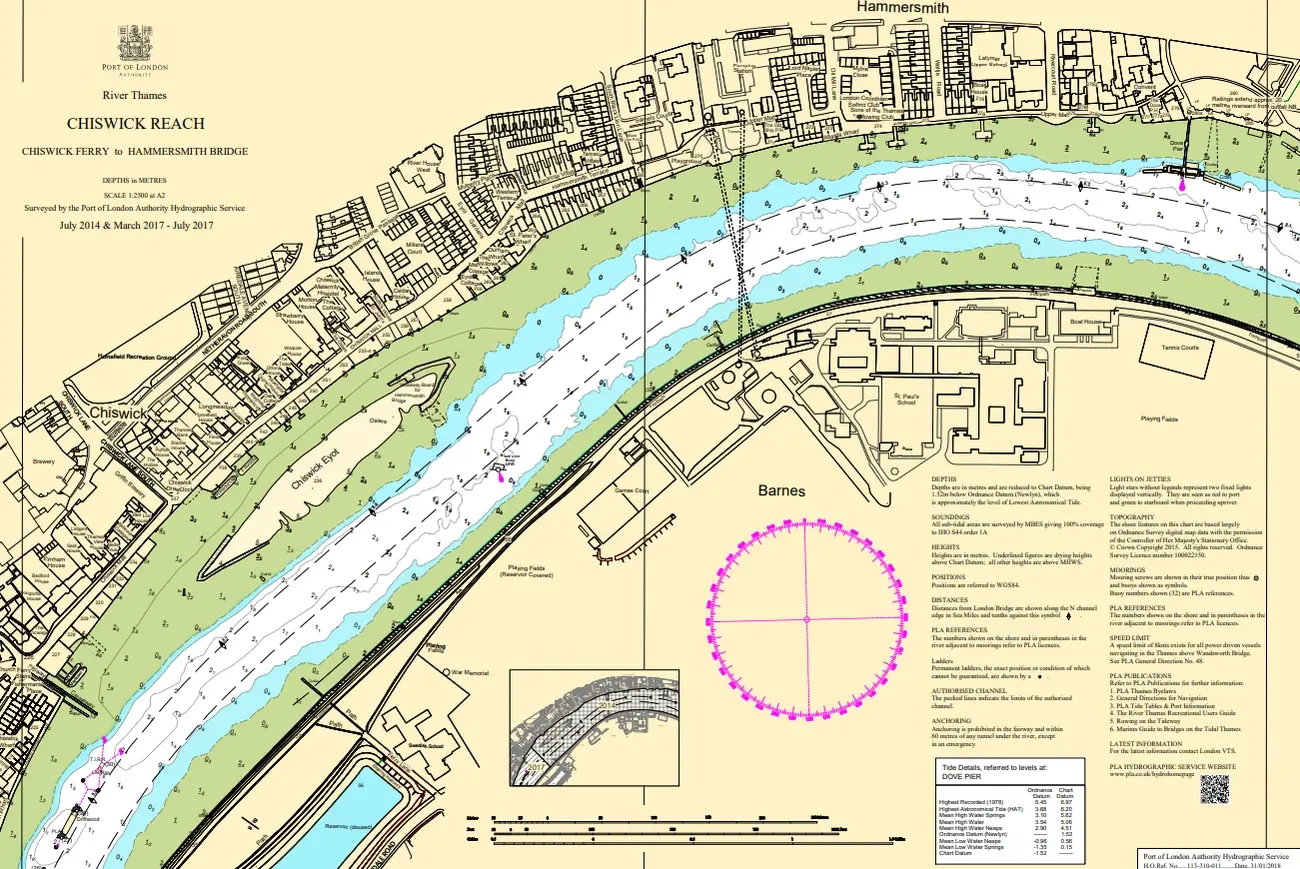
Image Source: Port of London Authority
Did you know that beneath the murky waters of the River Thames lies London’s longest archaeological site? It’s just waiting to be explored by modern-day treasure hunters! Mudlarking is one of the most hands-on and quirky things to do in London, giving you a proper connection with the city’s past that very few tourists ever get to experience.
What Is Mudlarking: More Than Just Mud!
The term “mudlarking” actually dates all the way back to the 18th and 19th centuries. Back then, it was usually impoverished Londoners – mainly youngsters between 8 and 15 years old – who would scavenge along the riverbanks at low tide. They were looking for anything valuable they could sell, like bits of coal, old rope, and metal scraps, often earning only about three pence a day! It’s a stark reminder of how tough life could be, and perhaps makes you appreciate modern comforts, like not having to worry about how to get rid of fruit flies in quite the same way!
These days, mudlarking has turned into a popular hobby. Enthusiasts search the foreshore for historical artefacts that have been amazingly preserved in the Thames’ anaerobic mud (that means mud without oxygen). Because oxygen can’t get into the mud, objects can survive in nearly perfect condition for centuries! With all the activity on and around the river over hundreds of years, the Thames foreshore is basically “one giant archaeological dig.” You can find anything from Roman bits and bobs to medieval treasures.
Permit Requirements: The Rules of the Riverbank
Right, this is important. If you want to search the Thames foreshore for anything at all, you now need a permit from the Port of London Authority (PLA). It used to be unrestricted, but they brought in a permit scheme in 2016 to help protect the historical importance of the Thames.
Currently, these permits cost £35 and they’re valid for one year. The PLA limits the total number of permits to 4,000 each year, and they don’t do automatic renewals. This is to make sure everyone who’s interested gets a fair chance to apply.
For safety reasons, you have to be over 12 years old to hold a permit. And if you’re under 16, you need to be accompanied by an adult who also has a permit while you’re searching. Another key rule is that any finds that are over 300 years old must be reported to the Portable Antiquities Scheme, which is run by the British Museum.
Best Locations: Where to Dig for History!
Even though mudlarking in central London needs a bit of careful planning, especially with the tides, there are several spots that are known for being good hunting grounds:
- Rotherhithe Beach: This is one of the easiest beaches to get to and has a small sandy strip. It used to be a Victorian dockyard area, so it’s excellent for finding old ship remains.
- Tower Beach: You’ll find this near Tower Bridge. It’s a popular spot because it has the remains of an old jetty and is steeped in history.
- Greenwich Beach: This area was once connected to Greenwich Palace. Amazingly, items found here can often be traced back to the palace itself, including old pots and cooking utensils!
Remember, you absolutely must check the tide times before you head out. The Thames can rise by over seven metres twice a day, and the current is fast and the water is cold! But if you’re careful and have your permit, this is one of the most fascinating and quirky things to do in London. It’s a real adventure that combines treasure hunting, history, and a bit of fresh air.
Visit the House of Dreams in East Dulwich: A Home Like No Other!
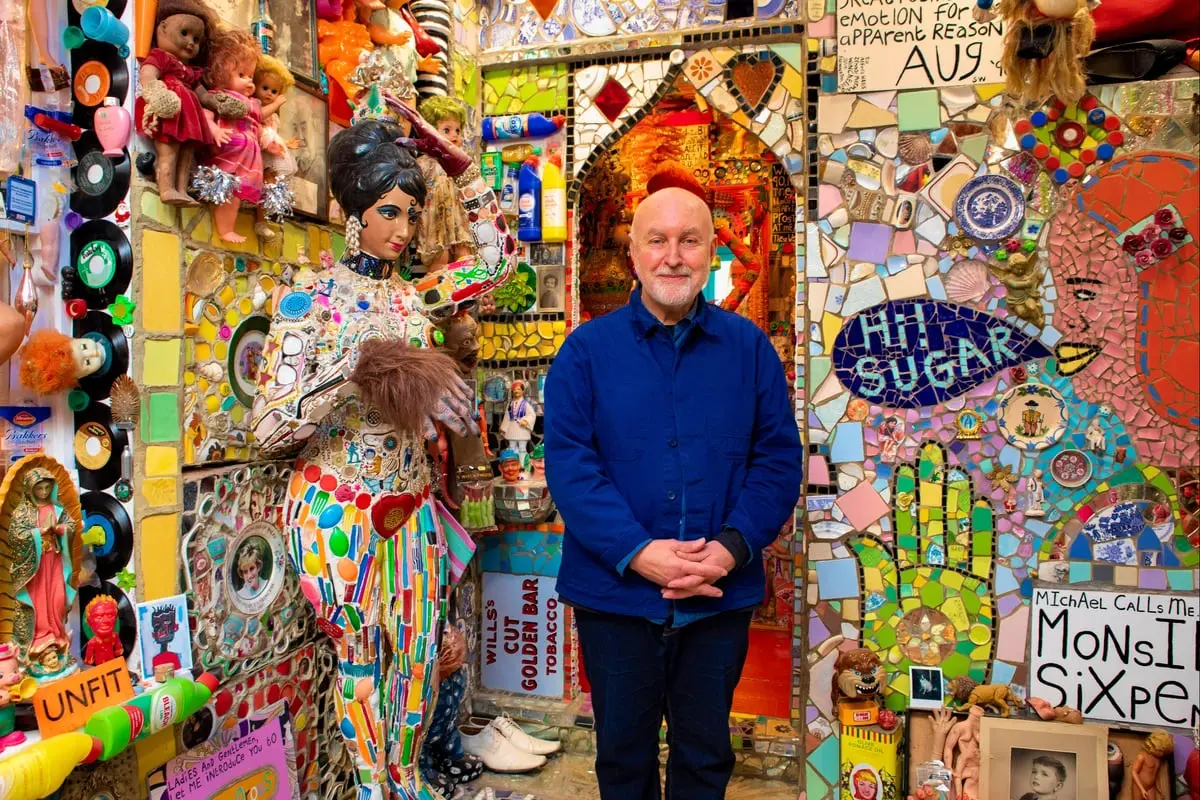
Image Source: Evening Standard
Tucked away on what looks like an ordinary residential street in East Dulwich, there’s an absolutely extraordinary art installation that’s cleverly disguised as a humble terraced house. The House of Dreams Museum is one of the most captivating and truly quirky things to do in London. It’s a technicolour testament to one man’s incredible artistic vision and his deeply emotional journey. If you’re looking for something totally unique, this is it!
What to Expect: An Explosion of Colour and Emotion
As you get closer to 45 Melbourne Grove, the vibrant blue gate and the psychedelic mosaic walls immediately tell you you’ve found somewhere very special. Once you step inside, prepare for a proper sensory overload! Every single surface you can imagine – walls, ceilings, floors, even the garden – has disappeared beneath this meticulously arranged, wonderful chaos of objects.
Throughout the ground floor, you’ll discover thousands of broken dolls that the artist, Stephen Wright, collected from places like Budapest, Prague, and Madrid. You’ll also spot everyday items like old toothpaste tubes, reading glasses, and bottle tops, all given a new life. And then there are the more unusual collections, ranging from false teeth to used wigs! It’s a world away from a typical pristine art gallery, and definitely not what you’d expect to find in a normal house in one of London’s many best places to live in London.
But this isn’t just random clutter. Covering the walls are handwritten “memory boards.” These feature raw personal reflections, bits of overheard conversations from public transport, political commentaries, and just random thoughts. As one visitor brilliantly put it, what sounds like it could be a bit creepy actually feels “magical,” leaving many people wandering through with “a big dumb grin” on their faces. I can totally see why!
Artist Behind It: A Labour of Love and Life
Stephen Wright started transforming his home way back in 1998. He was inspired by a TV programme about Outsider Art Environments that was presented by Jarvis Cocker (yes, from the band Pulp!). But mainly, the project became a kind of therapeutic diary for Stephen after he very sadly lost both his parents and his partner all within one year, back in 2006. So, while Stephen is a trained artist, this space represents his turn towards a much more raw and unfiltered way of expressing himself.
Alongside the personal trauma, the house also reflects Stephen’s love of travelling, especially to places like India, Mexico, and Paris. You’ll see objects he’s collected from these journeys woven into the artwork. His current partner, Michael Vaughan, often helps conduct the tours, and both of them bring such extraordinary warmth and openness to everyone who visits.
Booking Info: Your Glimpse into a Dream World
The House of Dreams opens its doors about once a month, welcoming around 100 visitors on each open day. Admission costs £10 per person, and children can get in free. However, you absolutely need to book in advance through Stephen Wright’s official website, as it’s incredibly popular.
Interestingly, while you can take photos in the gardens, they ask that you respect their privacy by not taking photos inside. This helps to preserve the truly immersive experience of being in the space. It’s important to remember that this isn’t just one of the quirky things to do in London; it’s also a lived-in home. Stephen and Michael live on the upper floors, with just the ground floor serving as the museum.
And here’s a lovely fact for the future: Stephen Wright has bequeathed the entire property to the National Trust. This means that this unique London treasure will be preserved to captivate future generations for years to come.
Take the Mail Rail Ride at the Postal Museum: Journey into Secret London!

Image Source: The Postal Museum
Deep beneath the busy streets of London, there’s a secret network of tunnels that’s a hundred years old! This amazing system once shuttled millions of letters every single day. Now, this old underground postal railway is part of The Postal Museum, and it offers visitors a brilliant chance to ride through London’s hidden postal history on these cool miniature trains. It’s easily one of the most quirky things to do in London, especially if you love history and secret stuff!
Mail Rail History: The Post Office’s Secret Underground
The idea for this underground railway was first suggested way back in 1855 by Rowland Hill, who was the Secretary to the Post Office at the time. He thought it would be a clever way to deal with London’s incredibly congested streets, which were causing serious delays to mail transport. Can you imagine trying to get important letters across London with all that horse and carriage traffic?
It took a while to get going, but in 1909, a special committee started looking into using underground pneumatic (air-powered) and electric railways. By February 1911, they recommended building an electric railway with driverless trains – how futuristic is that for the time!
The railway finally opened on December 5th, 1927. It connected sorting offices all across London through 6.5 miles of tunnels, running at an average depth of 70 feet below ground. Throughout its working life, this incredible Mail Rail transported over six million bags of mail every year – that’s about four million letters every single day! However, after an amazing 76 years of service, the system eventually closed down in 2003. It’s quite a thought, all those letters whizzing beneath your feet! Maybe it even helped deliver letters with advice on how to improve your credit score back in the day!
Ride Experience: All Aboard the Mini Train!
Today, you can take a 15-minute immersive journey that takes you right through the original tunnels on specially designed passenger trains. As you travel, a former Mail Rail engineer called Ray tells you all about its history through an audio recording. You move through these dark tunnels and past abandoned platforms where mail was once loaded and unloaded.
The train stops at different platforms where they use impressive digital projections on the walls to tell the railway’s fascinating story. One of the most atmospheric parts, I think, is when the train simulates a power cut by going completely dark for a moment! For anyone who can’t go on the ride, they even have a film showing the journey on the lower ground floor of the museum.
Museum Highlights: More Than Just a Ride!
But the fun doesn’t stop when you get off the train! You then get to explore the former engineering depot, which is now home to loads of interactive exhibits. The collection showcases some remarkable bits of history, including a 1927 battery-operated locomotive that was once used to rescue broken-down mail trains. There’s also an 1863 pneumatic truck – an almost unique survivor of a Victorian experiment in moving post underground.
Children especially love the hands-on activities, like racing little pneumatic trucks that are propelled along by air. They can also have a go at operating the switch frame that once controlled all the train movements. But the biggest hit for many is the replica Travelling Post Office carriage. Here, you can try sorting mail into pigeonholes while the floor shifts about to simulate being on a moving train! This interactive element makes it one of the really great fun things to do in London with kids. It’s one of those quirky things to do in London that’s educational too!
Watch a Film on 16mm Reels at Ciné Real: A Nostalgic Night Out!
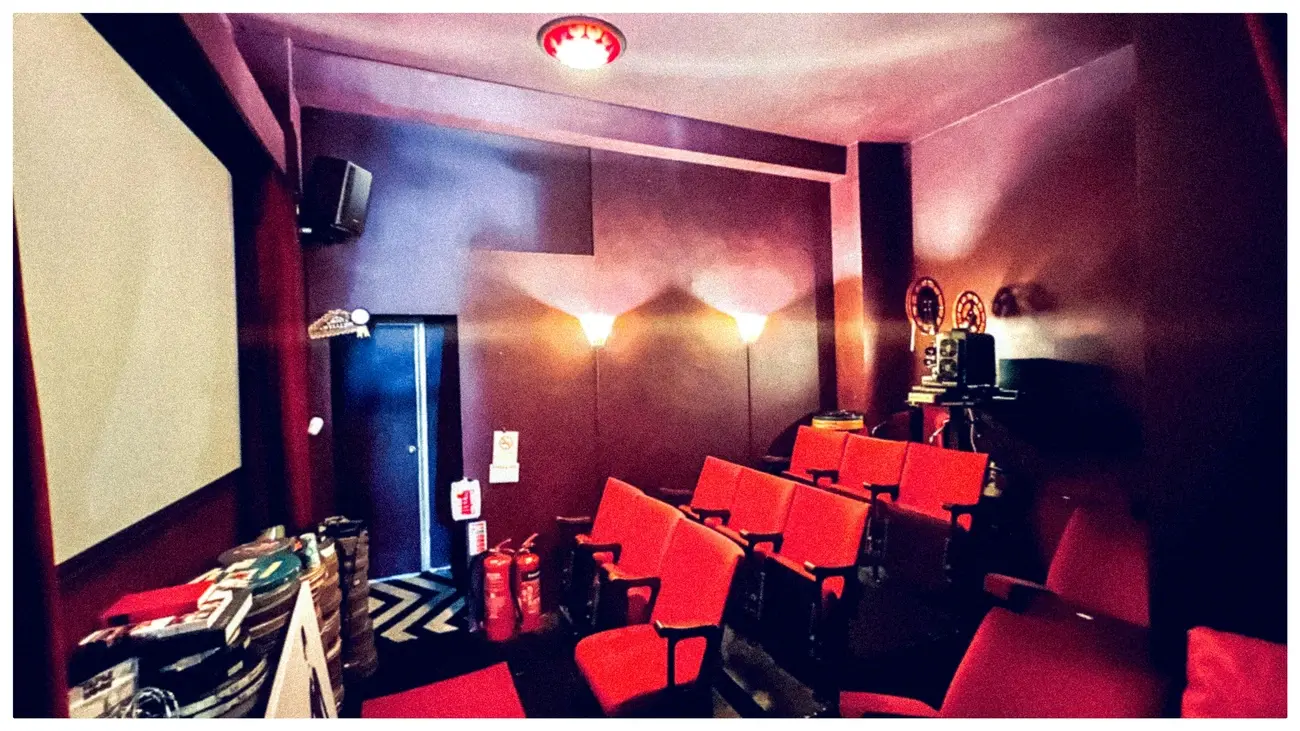
Image Source: CINÉ REAL
In this age of endless digital streaming and perfectly crisp HD everything, there’s something really special about experiencing the warmth and unique texture of proper 16mm film projection. It’s become a rare delight! Ciné-Real offers exactly this nostalgic pleasure. Believe it or not, it stands as the only film club in the entire UK to exclusively screen movies on genuine 16mm film reels. For film buffs, this is one of the truly unmissable and quirky things to do in London.
Ciné Real Experience: The Magic of Real Film
Founded way back in 2011, this unique cinematic adventure unfolds in the stunning art deco glamour of The Castle Cinema, which you’ll find in Homerton. What makes the whole experience so extraordinary is actually seeing the projectionist, Ümit Mesut, at work just a few seats away from you! You can see him operating his own equipment and even hear the gentle whirr and snap of the film as it plays. It’s magical!
Sometimes, the films will pause for an intermission. But this isn’t just for you to nip out for more popcorn; it’s mainly for reel changes, which is all part of the authentic experience. The selection of films they show varies really widely. One night it might be a classic like “The Maltese Falcon,” and another it could be Jean-Luc Godard’s “Alphaville.” There’s no set theme, other than their dedication to creating a great cinematic experience that feels totally different from your average multiplex. It’s a far cry from a typical night out, perhaps even more unique than trying to find the best shopping in London!
Why It’s Unique: The Feel of Analogue
The first thing to remember about 16mm projection is that it can reproduce colours in a way that digital formats just can’t – or at least, not in the same beautiful way. The founder, Liam Saint-Pierre, described it perfectly when he said, “It’s like the difference between sitting in front of an open fire compared to a radiator.” And he’s so right!
The journey to creating this wonderfully quirky things to do in London actually began when Liam Saint-Pierre found an old Super 8 projector in a skip in Hackney! He then met Ümit Mesut, a former projectionist with a massive passion for celluloid, and their shared enthusiasm blossomed into this brilliant, quirky London attraction. It just shows that amazing things can come from unexpected places!
How to Attend: Book Your Reel Adventure!
Before you plan your visit, make sure to check their website for upcoming screenings. Recently, they’ve shown gems like Charlie Chaplin’s “Modern Times” and Peter Bogdanovich’s “Paper Moon.”
Tickets usually cost around £10, which I think is great value for such a unique experience. Booking early is absolutely essential though, as their screenings often sell out completely. These popular events take place at The Castle Cinema, which is located at 35 Lower Clapton Road.
And here’s a really lovely touch for true film enthusiasts: if you want something really special, you can even hire the entire fifteen-seat screening room for a private showing. They’ll even throw in complimentary popcorn! Now, that sounds like the kind of date night you only usually see in the movies, doesn’t it? Perhaps one of the most unique things to do in London for couples?
Step into Dennis Severs’ House: A Time Capsule in Spitalfields!
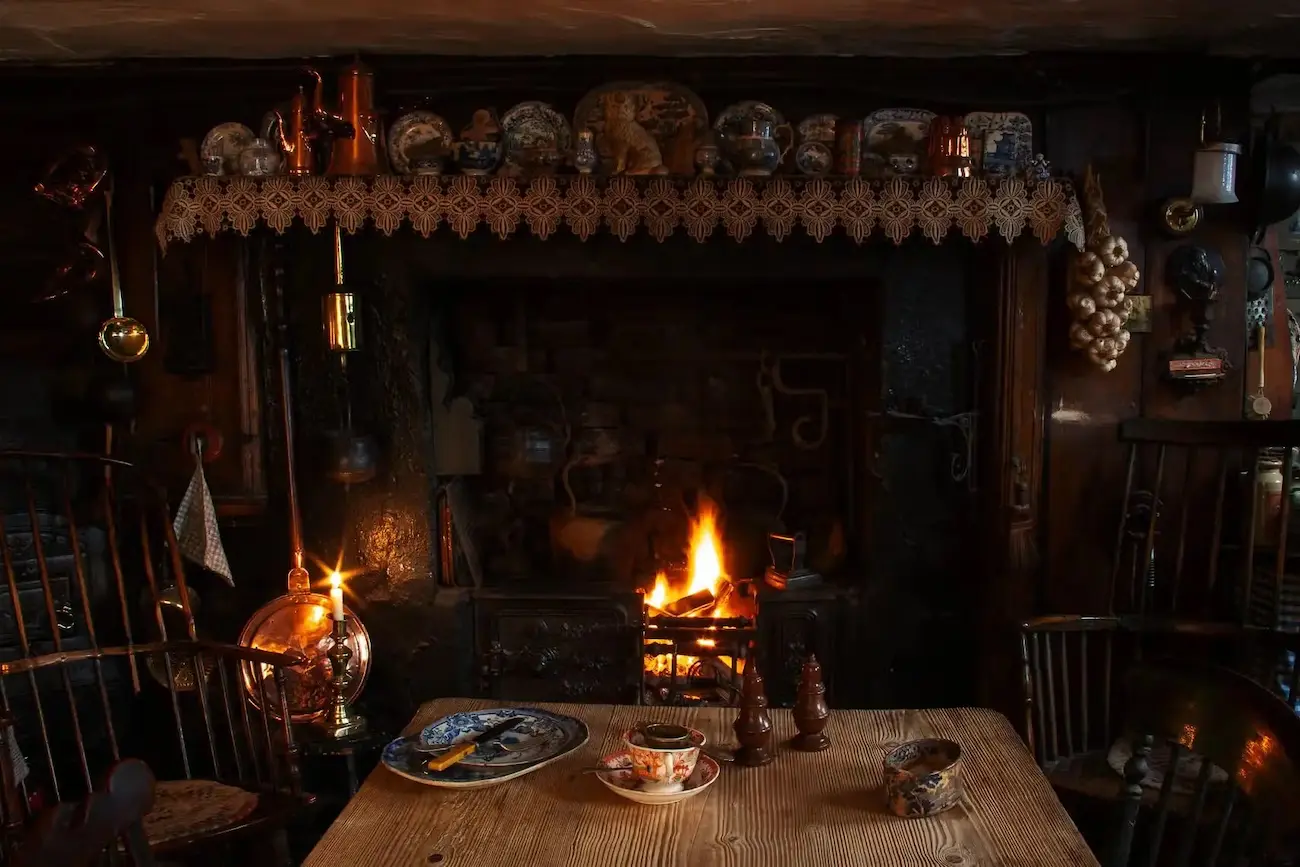
Image Source: Dennis Severs’ House
Ever wished you could step directly into the past, not just look at it through a glass case? Well, in Spitalfields, you can do something pretty close! Dennis Severs’ House at 18 Folgate Street is less of a museum and more of an extraordinary, atmospheric journey back in time. It’s one of the most uniquely quirky things to do in London, and an experience you definitely won’t find in any mainstream guidebook.
What Is Dennis Severs’ House: A “Still-Life Drama”
This isn’t your typical historical house tour. Dennis Severs, an American artist who lived there from 1979 to 1999, created what he called a “still-life drama.” He meticulously designed each of the ten rooms to tell the story of a fictional family of Huguenot silk weavers, the Jervis family, who might have lived there from 1724 to 1914.
As you move through the house, you progress through different historical periods. Each room is filled with authentic antiques, everyday objects, and even smells and sounds that make it feel as though the family has only just stepped out. You might see a half-eaten meal on a table, hear hushed conversations from another room, or smell the lingering scent of woodsmoke or perfume. It’s all about using your imagination and senses to piece together the family’s story. It’s a bit like being in one of those amazing immersive experiences in London, but on a much more intimate and historical scale.
Why It’s So Quirky and Unique: Silent Storytelling
The most unusual thing about Dennis Severs’ House is the way you experience it. Visitors are asked to explore in silence, or in hushed whispers, to maintain the atmosphere. There are no information plaques or guides explaining things in the traditional sense. Instead, you’re encouraged to absorb the details and let the house tell its own story.
The house is often lit by candlelight and firelight, adding to the incredibly evocative and slightly spooky feel. It’s not about historical facts and figures; it’s about feeling the presence of the past and the lives that were lived within those walls. It’s a deeply personal and thought-provoking experience, making it one of the most quirky things to do in London for anyone who loves history presented in an unconventional way.
Visiting Dennis Severs’ House: What You Need to Know
You’ll find Dennis Severs’ House at 18 Folgate Street, Spitalfields, London E1 6BX. It’s very close to areas like Shoreditch and Brick Lane.
- Booking: You absolutely must book your visit in advance through their official website. They have specific timed entry slots, and numbers are limited to keep the experience intimate.
- Opening Times: These vary, but they often have daytime “Silent Visit” slots and more atmospheric evening candlelight tours. Check their website for the most up-to-date schedule.
- Price: Ticket prices typically range from around £20 to £30 per person, depending on the type of tour (daytime or evening).
- Important Note: This experience might not be for everyone. It requires patience, quiet contemplation, and a willingness to engage your imagination. It’s also not really suitable for young children due to the silent nature and the fragile, historic contents of the house.
If you’re looking for something truly different, that steps away from the noise and bustle and offers a moment of quiet reflection on London’s rich past, then a visit to Dennis Severs’ House is an unforgettable and deeply quirky experience.
Explore the Crossness Pumping Station: A Victorian Engineering Marvel!
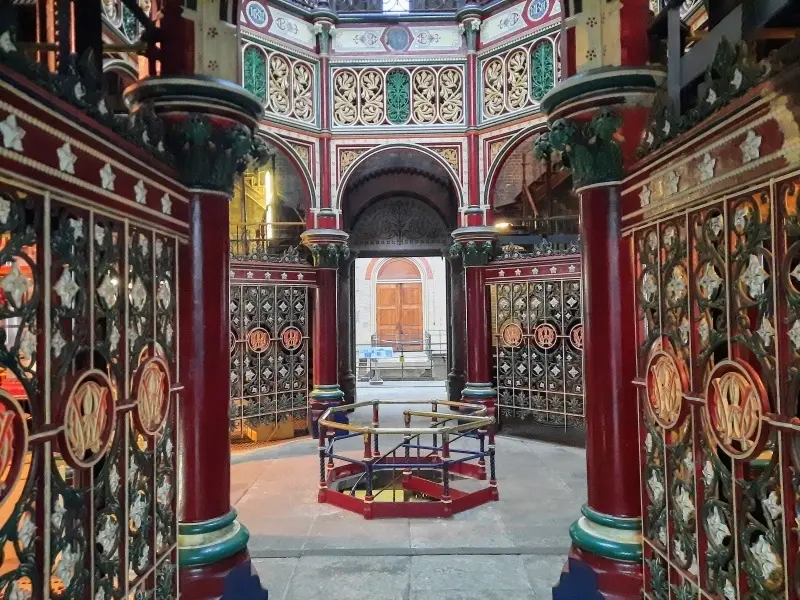
Image Source: Living London History
Way out in the marshes of southeast London, there’s a hidden Victorian masterpiece that honestly just blows your mind. Crossness Pumping Station, often wonderfully nicknamed “The Cathedral on the Marshes,” is an amazing contradiction. It’s a sewage facility that was built with the kind of decorative splendour you’d normally expect to see in a palace! This is one of those truly quirky things to do in London that will leave you speechless.
Victorian Architecture: Beauty in the Functional
Crossness was designed way back in 1865. It was a key part of Sir Joseph Bazalgette’s revolutionary London sewage system – a system that literally saved London from the “Great Stink”! What’s so incredible is the spectacular ornamental ironwork inside. It absolutely dazzles everyone who visits. The central octagonal engine house is filled with these intricately decorated cast-iron beams and arches, all painted in vibrant reds and greens.
The architect, Charles Henry Driver, created this amazing Romanesque style building with beautiful rounded arches over the windows. Inside, the ironwork is covered in elaborate floral patterns and geometric designs. It wasn’t just about being practical; this building really shows off the Victorian belief that even industrial buildings should have beauty and grandeur. The attention to detail is just incredible – they even included witty little touches in the ironwork, like figs and senna pod seeds (which are natural laxatives!) and pretty dogwood flowers (which were used at the time to prevent diarrhoea). It’s this kind of detail that makes exploring it so fascinating, a bit like when you finally learn how to descale a kettle properly and realise the difference it makes!
Why It’s Unusual: A Palace for Poo!
Without a doubt, the most surprising thing about Crossness is how deliberately beautiful it is, especially when you think about its very unglamorous purpose. It’s a Grade I Listed industrial heritage site, and its main job was to pump sewage from London’s sewers up 30 feet so it could be released into the Thames.
But instead of being purely functional, its magnificent neo-gothic “Jules Verne Victorianism” (as someone cleverly described it) transformed it into a proper work of art. In line with that amazing Victorian ingenuity, the facility kept working right up until the 1950s. After that, it was abandoned until the Crossness Engines Trust was formed in 1985 by dedicated volunteers. Now, these amazing volunteers have even restored one of the original four massive beam engines, the ‘Prince Consort’, to full working condition!
Tour Availability: See the Steam!
If you want to experience this unusual London attraction, you must book in advance. Tours for 2025 run on specific dates. Some of the most popular ones are the “steaming days,” when you can actually see that magnificent Prince Consort beam engine in operation – it’s an incredible sight!
For 2025, the steaming days I’ve seen listed include:
- May 18th
- June 22nd
- July 20th
- August 17th
- September 21st
- October 19th
Each tour usually lasts about three hours. Ticket prices are around £18 to £22.50 for adults (depending if it’s a steaming day or standard guided tour) and around £4 to £8 for children aged 5-15, with under 5s often going free. The experience usually starts with a talk or a video about Victorian London’s sanitation problems (the Great Stink sounds awful!). Then, you get a guided exploration of the history, the incredible engineering, and the stunning architecture. It’s a fantastic day out and truly one of the most quirky things to do in London.
Have a Drink at a Hidden Speakeasy: Shhh, It’s a Secret!
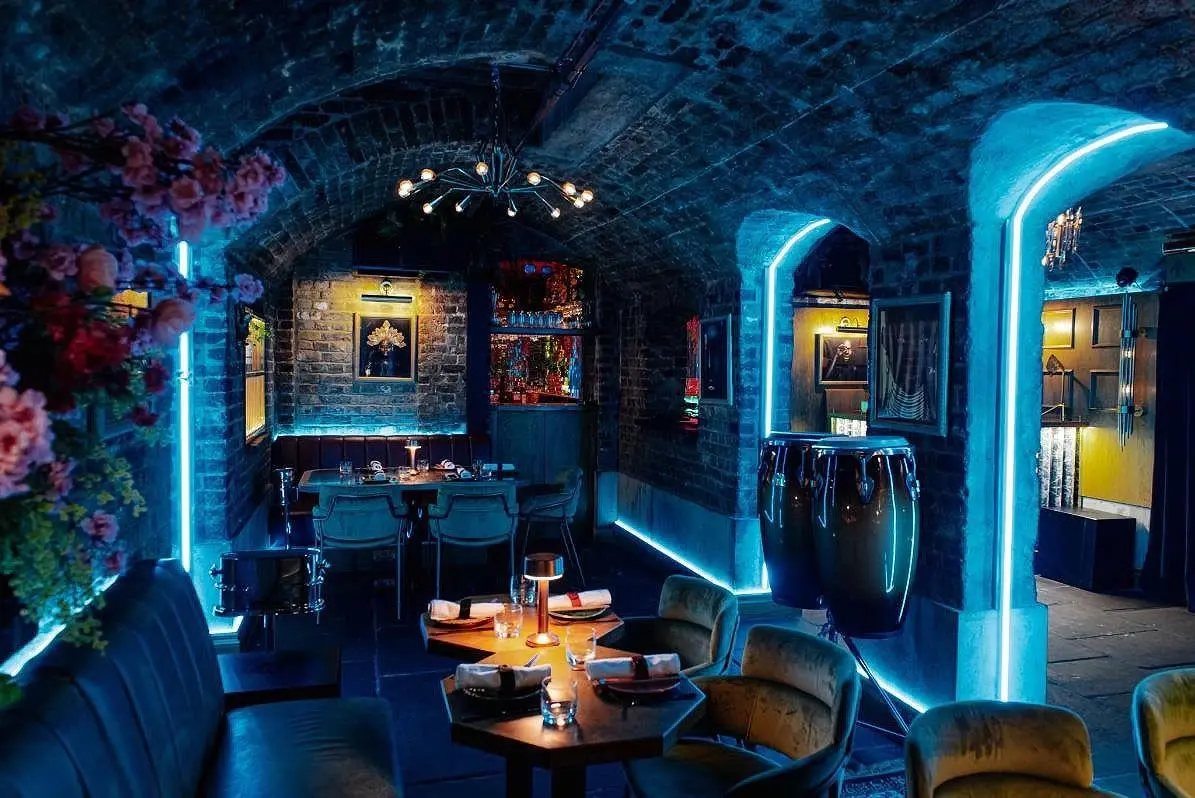
Image Source: Quintessentially
Right, fancy a bit of mystery with your martini? Behind unmarked doors, sometimes hidden inside what looks like an ordinary fridge, or even concealed behind bookshelves, lies London’s thriving speakeasy scene. These secret drinking dens are inspired by the Prohibition-era bars of 1920s America, when selling booze was illegal! Finding these is one of the most exciting and quirky things to do in London.
Top Speakeasies in London: Where to Find the Secret Sips
I’ve managed to sniff out a few standout speakeasies that definitely deserve a spot on your list of quirky things to do in London:
- 69 Colebrooke Row: This place is so cool, it’s often just called “The bar with no name.” You’ll find it hidden away on an Islington backstreet. It’s a chic little spot that’s absolutely dedicated to the art of the mixed drink. I’ve heard they do outstanding cocktails, and it’s apparently a favourite of celebs like Paul Mescal!
- Nightjar: This one has become so popular that it’s busy even in the middle of the week! They’ve got spots in both Shoreditch and Soho. Their cocktail list is amazing – it’s divided into historical eras (like pre-Prohibition and post-war) and features really unexpected ingredients. Think vodka mixed with almond milk, green matcha tea, and kefir lime tincture!
- Evans & Peel Detective Agency: Now this is where the speakeasy concept gets really theatrical! When you arrive, you’ll face an intercom interrogation before you even meet a dapper chap who’ll ask you about your “case.” The bar itself is then hidden behind a bookcase in what looks like a private detective’s office. It’s brilliant fun!
- Opium: Tucked away in Chinatown, you’ll need to look for a jade-coloured door on Gerrard Street to find this one. Inside, the design is a cool mix of an old-style smoking den and a trendy hipster hangout. There are vases and burning incense mixed with funky beats and retro armchairs that look like they’ve come straight from your nan’s sitting room! It’s a world away from some of the more traditional 17 Best London Afternoon Tea spots, that’s for sure!
How to Find Them: The Thrill of the Chase!
Part of the fun of these places is actually finding them! You need to look out for:
- Unmarked doors (like at Nightjar and Opium).
- Everyday objects that are actually secret entrances (The Mayor of Scaredy Cat Town, for example, is accessed through a big SMEG fridge door!).
- Businesses that aren’t quite what they seem (like Evans & Peel pretending to be a detective agency).
Alternatively, some speakeasies, like The Bootlegger in Leadenhall Market, require reservations or “appointments.” They really go for the theme, with staff often in braces and bow ties, and low lighting creating that perfect secretive vibe.
What to Expect: Cocktails and Character
Once you’re inside, you’ll usually find meticulously crafted cocktails served in unique and interesting glasses or vessels. The atmosphere is all about exclusivity and a bit of theatricality. You might find yourself in a vaulted basement space like at Purl, or even in The Brig, which claims to be London’s smallest speakeasy and offers bespoke cocktails from your very own private bartender!
Prices do tend to be a bit more on the premium side, but that reflects both the quality of the drinks and the whole unique experience. In short, these places don’t just serve you a drink; they give you an immersive performance that can transport you to another era. It’s such a cool way to spend an evening.
Take a Walk Through London’s Mews Streets: Cobbled Charm and Hidden History!
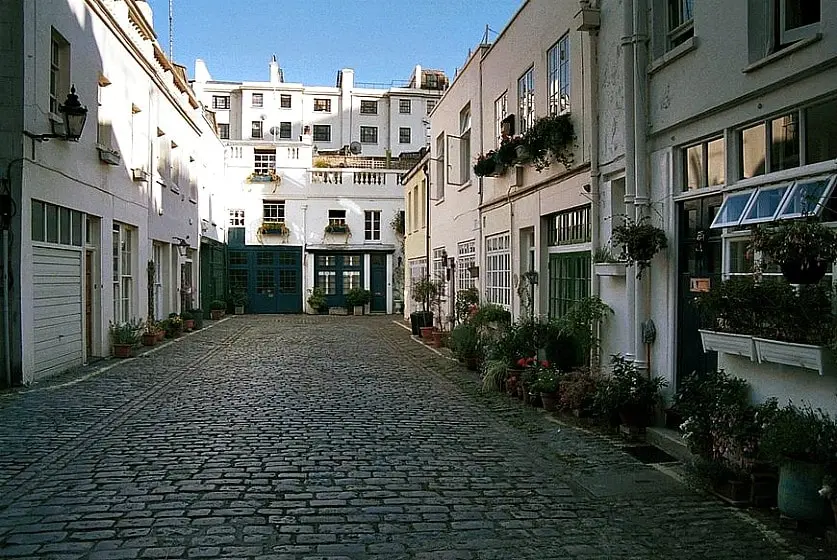
Image Source: Lurot Brand
Tucked away between London’s grand and bustling main roads, there’s a whole network of lovely cobblestone alleyways. These hide some amazing historical treasures that most tourists completely overlook. These picturesque little lanes are known as mews streets, and they offer gorgeous glimpses into London’s aristocratic past, alongside some absolutely stunning photo opportunities. Discovering these is one of my favourite quirky things to do in London.
What Are Mews: From Stables to Swanky Homes!
So, what exactly are mews? Well, they were originally built back in the 18th and 19th centuries. Their main job was to be stables and carriage houses for the grand homes nearby. They also had living quarters above for the servants who looked after the horses. It’s fascinating to think about!
Then, of course, cars came along and replaced all the horse-drawn carriages. After that, these practical, utilitarian buildings started to transform into some of the most coveted residential properties in London! Their distinctive architectural features are just so charming – you’ve got the cobblestone streets, the converted stable doors, old coach house entrances, and often beautiful flower boxes overflowing with colour. It’s amazing to think that what started out as functional service alleyways have now become some of London’s most expensive and sought-after addresses. It’s a bit like finding one of those amazing hidden fast food restaurants – a real hidden gem!
Best Mews to Visit: My Top Picks for Picturesque Lanes!
Several mews streets really stand out because they are just so exceptionally charming. Here are a few of my favourites:
- Kynance Mews in South Kensington is probably one of the most famous. It boasts these incredible ivy-covered walls, gorgeous hanging wisteria in the spring, and a really picturesque archway entrance. It’s particularly popular on Instagram, and I can totally see why!
- Bathurst Mews, which is near Hyde Park, is extra special because it remains London’s last working mews! It still has functioning stables, and you can often watch the horses being exercised there. How lovely is that?
- St. Luke’s Mews in Notting Hill is another famous one, mostly because it features the iconic pink house from the film “Love Actually.” A must-see for film fans!
- Warren Mews in Fitzrovia offers a quieter, more peaceful alternative. It has some really striking blue doors and lovely red brick facades.
Honestly, each mews has its own distinct character and beautiful architectural details that are just crying out to be explored. Wandering through them is such a peaceful escape from the city buzz.
Photo Tips: Capturing the Cobbled Charm
If you want to get the best photos of these charming lanes, I’d suggest visiting early in the morning – definitely before 9 am if you can. This way, you’ll avoid most of the tourists and, importantly, fewer parked cars will be blocking your lovely shots!
Because these mews are quite narrow, a wide-angle lens on your camera (or phone!) works really well for capturing the whole streetscape. And, of course, it’s really important to respect the residents’ privacy. Try not to photograph directly into their homes or block any entrances.
Throughout the year, different mews will showcase different seasonal beauty. You’ll find stunning wisteria in May, beautiful autumn colours in October, and sometimes even lovely Christmas decorations in December. These all help to illuminate these hidden passages with a truly magical charm, making a mews walk one of the most delightful and quirky things to do in London.
Visit the Fan Museum in Greenwich: A Breeze Through History!
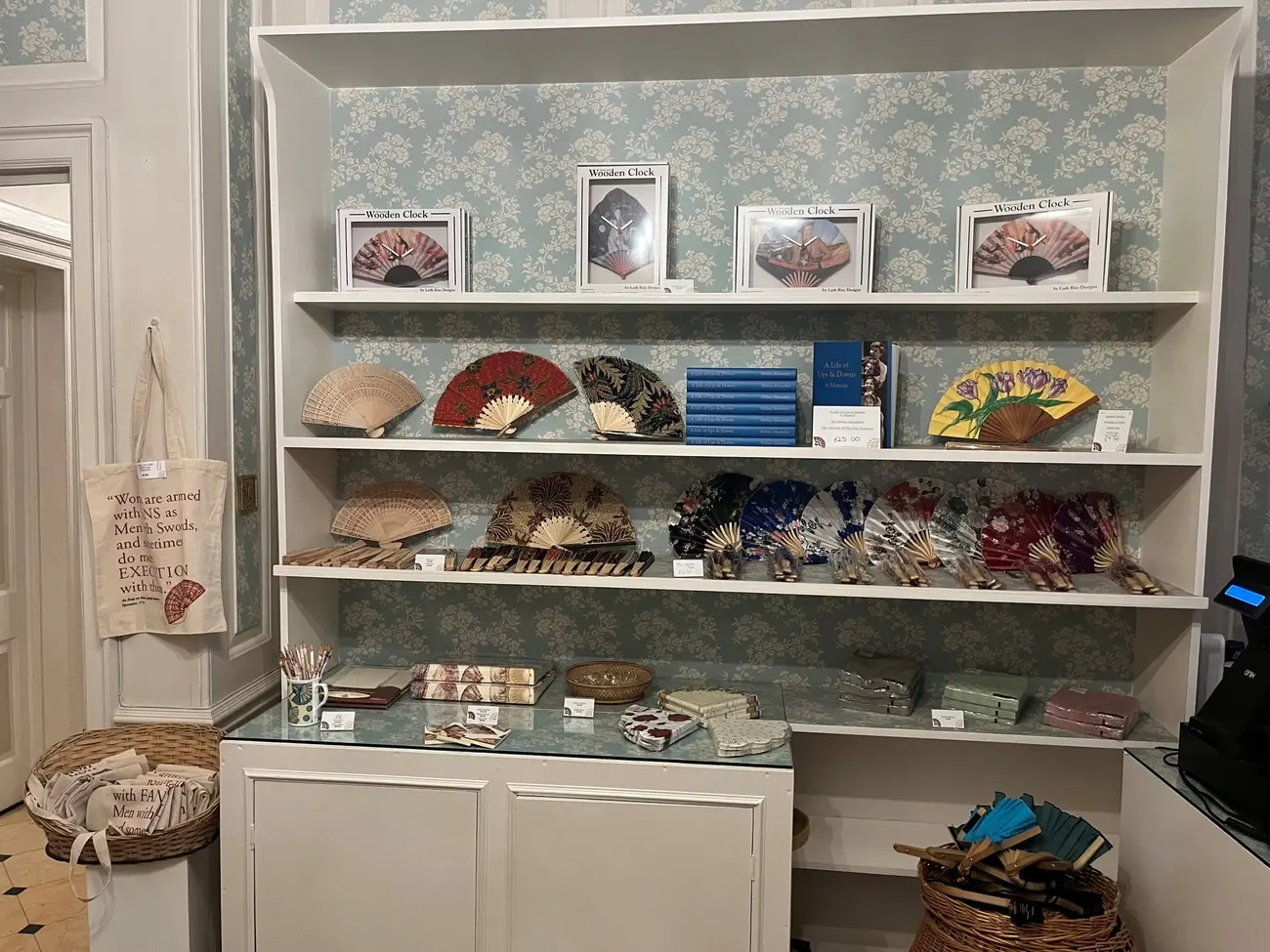
Image Source: www.thefanmuseum.org.uk
Now, this is a truly charming and one of the most delightfully quirky things to do in London! Housed within a pair of absolutely exquisite Grade II* listed Georgian townhouses in lovely Greenwich, you’ll find the world’s only museum that’s devoted entirely to fans. Yes, actual handheld fans! The Fan Museum is such a wonderful change from London’s mainstream attractions, and it offers visitors a fascinating glimpse into an often-overlooked art form.
Fan Museum Highlights: More Than Just Hot Air!
This museum is home to an extraordinary collection of over 5,000 fans, with some dating back a whopping 1,000 years! Can you believe it? These range from absolutely exquisite 18th and 19th-century examples, all the way through to more contemporary designs. When I last checked, the museum was getting ready to showcase “In Performance: Fans of Theatre, Music and Dance” (which is scheduled to run until May 31st, 2025).
Beyond the permanent collection that you can see on the ground floor, they have rotating exhibitions on the first floor. This is great because it means if you visit again, you’ll always discover something new and exciting. Most notably, the collection includes some really special pieces, like works by fine artists such as Paul Gauguin, some incredibly rare Elizabethan-period fans, traditional Japanese Court fans, and even a spectacular Fabergé fan that incorporates beautiful gold work and enamelling. Wow! The museum’s treasures are displayed within beautifully restored period rooms, which really adds to the historical atmosphere. It makes you think about how different life was, perhaps even considering things like how people managed without modern conveniences like the best dehumidifiers we have today!
Why It’s Unique: A World of Fans!
As the only organisation in the UK that’s devoted entirely to the history, culture, and craft of fans, this museum really is a testament to the passion of its founder, Hélène Alexander. It opened its doors in 1991 and brings together two collections of international renown.
Primarily, what you learn here is that fans weren’t just for keeping cool! They actually served as really important social and cultural symbols. Across various cultures, fans were used to convey messages, express emotions, and even indicate your social status. It’s so fascinating!
The museum also features a beautifully mural-adorned orangery and a lovely secret Japanese garden, which create such an enchanting atmosphere. And if you fancy getting creative, throughout the year they offer fan-making workshops where visitors can actually try their hand at this traditional craft. How cool is that for one of the most quirky things to do in London?
Visitor Info: Plan Your Fan-tastic Trip!
You’ll find The Fan Museum at 12 Crooms Hill, Greenwich, London, SE10 8ER. It’s pretty easy to get to via multiple transport options. It’s about a 7-minute walk from Greenwich Station and just 5 minutes from Cutty Sark DLR station.
The museum is open Tuesday to Saturday, from 11 am to 5 pm, with the last admission at 4:30 pm. Adult entry usually costs around £5, while children (aged 7-16), students, and seniors can get in for about £3. Children under 7, disabled visitors with their carers, and Art Fund members often enjoy free entry.
And here’s a lovely little tip: senior citizens usually receive free entry on Wednesdays! That’s a really thoughtful touch for anyone exploring London on a bit of a budget.
Conclusion: Your Amazing London Adventure Awaits!
Wow, London clearly offers so much more than just the standard tourist circuit, doesn’t it? Throughout this whole exploration of the city’s wonderfully weird side, we’ve discovered everything from sleeping right next to lions and riding in floating hot tubs, to exploring abandoned underground stations and stepping back in time in a candlelit house! These unusual attractions really show off London’s multifaceted personality, which goes far beyond Big Ben and Buckingham Palace. This list of quirky things to do in London is just the start!
What makes these quirky experiences so special, I think, isn’t just how new or different they are. It’s their amazing ability to connect you, as a visitor, with some truly authentic aspects of London’s incredible history, its vibrant culture, and its unique character. Honestly, going mudlarking along the Thames gives you such a hands-on link to centuries of London life that you just can’t get from looking at things in a museum display. In the same way, the stunning Victorian splendour of the Crossness Pumping Station shows off brilliant British engineering that’s so beautiful it’s like a work of art. It’s these kinds of experiences that make you appreciate the sheer depth of the city, maybe even inspiring you to look into the best universities in London if you’re considering a longer stay!
The real beauty of these alternative attractions is that they can surprise even people who’ve been to London loads of times. After all, who would expect to find a dazzling neon wonderland in Walthamstow, or a tiny, charming museum dedicated entirely to fans? These hidden gems offer a fantastic escape from the overcrowded tourist hotspots, and they definitely give you much more memorable stories to share when you get home.
Now, some of these experiences, like riding the Mail Rail or having that amazing sleepover at London Zoo, do need a bit of advance planning. But others, like wandering through the secret St. Dunstan-in-the-East garden or exploring those picturesque mews streets, can be spontaneously added to any London itinerary. Whether you prefer active adventures or more thoughtful and contemplative experiences like a Pitch Black Playback session, London’s quirky side really does cater for all sorts of preferences.
So, next time you visit London, I really hope you’ll think about stepping beyond the typical guidebook recommendations. The city’s true character is just waiting to be discovered in these unusual corners, where history, art, and a touch of eccentricity all blend together to create experiences you genuinely won’t find anywhere else. Trust me, seeking out these quirky things to do in London will make your trip unforgettable!
FAQs: Your Quirky London Questions Answered!
Got a few more questions buzzing around about all the quirky things to do in London? No worries, I’ve put together some quick answers for you!
Q1. What are some unique and non-touristy activities to do in London for 2025?
A1. Oh, London is packed with them! Some of the top hidden gems for quirky things to do in London that locals love for 2025 include exploring the neon wonderland of God’s Own Junkyard, taking a ride in a floating hot tub on the Thames, or visiting the truly bizarre Viktor Wynd Museum of Curiosities. Stepping into the time capsule of Dennis Severs’ House is another amazing one. These unusual attractions give you a completely different view of the city, far from the usual tourist trails.
Q2. Are there any hidden historical sites worth visiting in London?
A2. Absolutely! You should definitely consider touring the abandoned Aldwych Tube Station for a fascinating glimpse into London’s secret underground history. Or, why not explore the beautiful secret gardens of St Dunstan-in-the-East? It’s a bombed-out church that’s been turned into such a peaceful oasis. The Crossness Pumping Station, often called the “Cathedral on the Marshes,” is another incredible hidden gem that showcases Victorian engineering and stunning architecture. These are all fantastic quirky things to do in London if you love history.
Q3. What unique cultural experiences can I have in London?
A3. For a truly distinctive cultural experience, you could try attending a Pitch Black Playback listening party, where you hear whole albums in complete darkness – it’s intense! Or, watch a classic film on proper 16mm reels at Ciné Real for a bit of nostalgia. You could also explore London’s cool speakeasy scene for a taste of 1920s-inspired cocktail culture, or visit the charming Fan Museum in Greenwich for an unexpected and fascinating dive into the art and history of fans.
Q4. Are there any unusual outdoor activities available in London?
A4. Yes, London offers several brilliant and quirky outdoor experiences! You could try your hand at mudlarking on the Thames foreshore, searching for historical artefacts washed up by the tide. Or, take a lovely, peaceful walk through London’s charming mews streets with their cobblestones and flower boxes. Exploring the atmospheric ruins of St. Dunstan-in-the-East also counts as a unique outdoor venture. These offer a different pace to city life, much like enjoying one of the easy day trips from London can.
Q5. What are some lesser-known museums in London worth visiting?
A5. London is home to some absolutely fascinating niche museums that often get overlooked! The Postal Museum offers that amazing ride on the underground Mail Rail, which is such fun. The Viktor Wynd Museum of Curiosities, as I mentioned, showcases a truly eclectic and bizarre collection of oddities. The Fan Museum in Greenwich is utterly unique, and the incredible House of Dreams in East Dulwich offers an insight into an artist’s personal world. These are all fantastic alternatives to the more mainstream museums and are definite highlights when you’re looking for quirky things to do in London.
